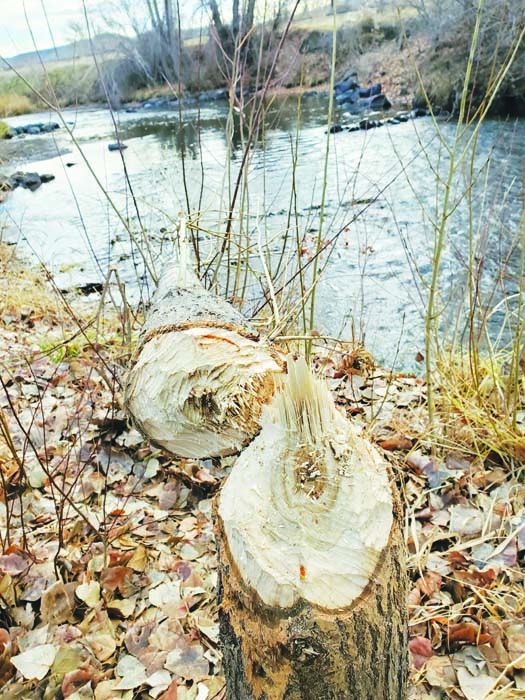Baker City — with an assist from beavers — trims, removes trees to address possible hazards along Adler Parkway
Published 10:09 am Tuesday, February 13, 2024

- Although humans have done much of the work to reduce hazards from trees along the Leo Adler Memorial Parkway, beavers have also contributed to the campaign by gnawing through cottonwoods and willows along the southern section of the path along the Powder River. This tree is near Wade Williams Elks Memorial Park, south of Myrtle Street.
Baker City is seeking to address current and future hazards to the public posed by trees growing along the Leo Adler Memorial Parkway.
The paved pedestrian and bicycle path, which honors Adler, the city’s longtime benefactor who died in November 1993, follows the Powder River through much of the city.
The trail’s northern terminus is just south of Hughes Lane. Its longest section ends at Bridge Street, and a shorter section in south Baker City starts at Myrtle Street and runs along the edge of Wade Williams Elks Memorial Park.
Over the past few weeks the city, along with employees from its parks and cemetery maintenance contractor, HnT Lawn Care Inc. of Baker City, have pruned or removed several dozen trees near the trail, said Jennifer Murphy, technical administrative supervisor for the public works department.
Oregon Trail Electric Cooperative has also removed or trimmed trees that encroach on the cooperative’s power lines, Murphy said.
The chief concerns, botanically speaking, are cottonwood and willow trees, both of which are common along the riverside path, Murphy said.
She said she and Eric Pierce, of HnT Lawn Care, walked the pathway a couple months ago to assess the situation.
In some cases, tree branches were jutting over or near the path, she said.
Elsewhere, trees were leaning toward the path and likely would fall across it if they were toppled.
Trees that needed to be trimmed or removed were marked with dots of pink paint.
Safety wasn’t the only goal, though.
Murphy said the trimming and tree removal also has an aesthetic aspect. Left untended, the foliage can form a veritable jungle that not only obstructs views of the river — one of the reasons it was built about a quarter century ago — but also impedes anglers and others from reaching the water.
Although the recent trimming was a city project, Murphy said the work builds on the efforts of volunteers, led by Tom Clement, starting several years ago.
“Tom and his crew have done an amazing amount of work,” she said.
They trimmed and removed trees, including ones that posed a threat not to walkers but to people floating the river on hot summer days.
The volunteers removed many branches that extended across, and depending on the river level, into the water.
Clement said in 2020 that in addition to getting rid of hazards, he hoped to improve the health of remaining trees.
Although water-loving willows and cottonwoods are the predominant species along the river, there’s a smattering of box elders, cherries and even a few mountain ash trees with their distinctive clumps of eye-wateringly orange berries.
Assist from Oregon’s state animal
The scope of the task has been pared somewhat by the work of rodents, Murphy said.
A colony of beavers, with their appetite for twigs, leaves and bark, have gnawed through many trees, including cottonwoods and willows, along the southern section of the trail near Wade Williams.
“The beavers are doing a great job,” Murphy said. “There’s a lot of young cottonwoods there.”
The beavers, of course, work for free.
But the city has not had to spend extra for the recent trimming, either, because work along the parkway is part of the city’s contract with HnT Lawn Care.
Murphy said the city renewed that contract in February 2023, extending it through 2026, with an option to continue it for three more years.
The city pays $5,234 per month for park maintenance, which includes the Adler Parkway, and $8,708 per month for maintaining Mount Hope Cemetery, a total of $160,000 per year.
Murphy said the current project is finished. Winter is a good time to prune, she said, since trees are dormant.
More trimming could happen this fall.
“It’s a continual challenge,” Murphy said. “We’ll always have work as long as we have cottonwoods and willows.”
Besides the hazards the trees themselves can pose, their roots have buckled the asphalt path in several areas.
In 2017, city crews, using a $15,000 grant from the Cycle Oregon foundation, fixed some of those spots, including on the northern section between D Street and Hughes Lane. They also installed a plastic root barrier along both sides of the path near H Street, which is designed to prevent roots from spreading beneath the asphalt.





